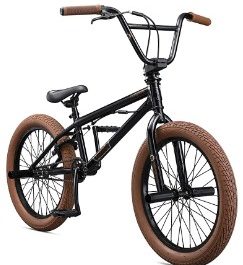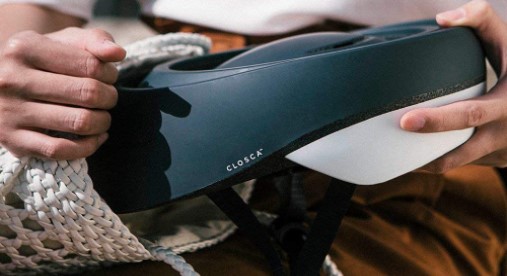Having a helmet that both ensures your safety and is easy to pack in a bag and carry around is convenient, bringing the idea of a foldable helmet. However, are foldable bike helmets safer than traditional ‘non-foldable’ helmets?
Same as traditional ‘non-foldable’ helmets, foldable helmets have to be CPSC certified before being approved for use to ensure that they can withstand impact, are durable, strong, and use good quality materials. That makes them safe as long as they are certified.
Bike-sharing commuters inspired the main idea behind a folding helmet. Designers tried to develop a lightweight, compact helmet that keeps the rider safe and is easy to pack.
In this article, I will discuss factors that make foldable bike helmets equally safe as traditional helmets. I will also look at some of the finest foldable helmets on the market today.
Let us first define a foldable bike helmet.
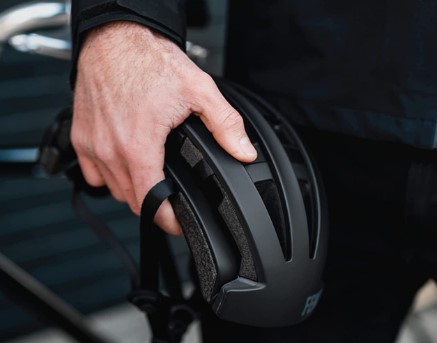
What’s a Foldable Bike Helmet?
A foldable helmet, also known as a compact bike helmet, is made to collapse, taking up very little space. Other than folding, a compact helmet needs to maintain the volume of its material.
There are two common types of designs: stack and flat-pack.
While the stack design is divided horizontally and compresses from the top, the flat pack design collapses from the sides.
The first foldable helmet was manufactured in 1997, the Motorika Snapit, which would reduce in size by half by collapsing one side into the other.
This helmet, however, was quite heavy, and the design wasn’t that pleasing to the eye. It didn’t last long in the market. Some of the others that followed do not meet the CPSC safety standard and aren’t available in the US.
Developing a light and stylish helmet that protects during impact and is foldable has been the effort of designers, which seems to have paid off.
Some of the best certified foldable bike helmets are:
- Closca helmet
- Fend foldable bike helmet
1. Closca Foldable Bike Helmet
Closca helmets (Check on Amazon) have a three-piece design that collapses into each other when folding. The two top pieces collapse into the bottom one. That means that the helmet can easily fit into a flat bag.
Closca helmets are modern and stylish, with many different colors on the helmet and the visor. They are light, weighing between 250g and 300g. These helmets meet both the CPSC and EN 1078 safety standards.
Closca helmets embrace technology. They have an inbuilt NFC chip that stores important information such as medical history and emergency information.
Most importantly, these helmets are very comfortable, thanks to the soft padding used on the interior. They are also effortless to fold.
There are some downsides, however, to Closca helmets.
They are not well-ventilated, as no vents are facing the front. That could bring about uncomfortable rides, especially when cycling long distances under the sun. They also do not have padding on the chin strap.
Even though they fold into a disc shape of just a few inches tall, they do not fold diameter-wise, and therefore you will need a bag about the size of a lunchbox to carry it around.
On average, Closca helmets are good quality and quite pocket-friendly compared to some foldable bike helmets.
2. Fend Foldable Bike Helmet
Christian Heifner founded fend. The idea to design a stylish, easy-to-carry helmet came to him after getting into an accident when cycling without a helmet.
Fend has one arch at the top of the head where the sides fold. Despite claiming to reduce in size by up to 50%, unlike Closca, it doesn’t flatten.
Fend One Bike Helmets (Check on Amazon) are CPSC and EN 1078 certified. They are lightweight, with an average helmet weighing about 400g.
With a dial fit system installed, extra pads, and adjustable straps, these helmets can fit a variety of head shapes and sizes.
Thanks to their excellent folding mechanism, they are easy to fold and unfold. They have latches on the sides that can be pulled when unfolding and squeezed when folding.
These helmets come in three colors: matte black, matte white, and matte/” NY” yellow.
The main difference I have found with the Fend helmets is that they are very well-ventilated. Their ventilation gaps are enormous, and despite fears that the helmets are unsafe, they are both CPSC-approved and rider-approved.
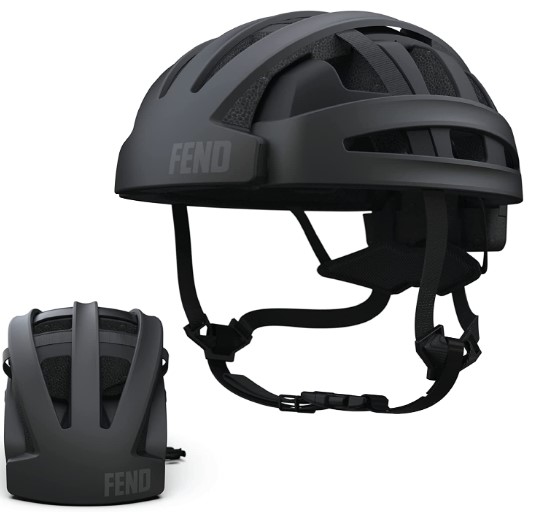
Are Foldable Bike Helmets Safer?
As I mentioned earlier, foldable bike helmets are just as safe as traditional helmets. Here is why:
a) Certification (Most Foldable Helmets Are Certified, Thus Safer)
For a foldable bike helmet to be certified, it is subjected to testing under different conditions, such as in hot and cold weather and underwater.
The tests ensure that the peripheral vision is clear and that the helmet will remain on your head in the event of a crash.
To ensure that the straps do not stretch too much, compromising safety during impact and that the helmet absorbs shock, the helmet is first placed on a head-shaped foam as it should be worn on an actual head, then tested.
Once a foldable helmet passes these tests, it is approved for use with a CPSC sticker.
b) Comfort (Most Foldable Bike Helmets Are Comfortable, Thus Safer)
Comfort is essential in a helmet. You want to cycle without a heavy helmet weighing on your head. Most foldable helmets have been made from lightweight material to boost your comfort.
Since they have adjustable straps, it is easy to ensure your helmet’s fit is right. It shouldn’t be too tight or too loose.
Despite being made from collapsible material, foldable helmets are well-ventilated. That provides sufficient airflow during your commutes.
c) Good Fit (Most Foldable Helmets Have a Good Fit, Thus Safer)
Foldable helmets are designed to fit in your head perfectly, covering all exposed parts of the head.
Their shock absorption mechanism ensures no damage is caused to your skull from impact.
So do not just buy a helmet simply because it is foldable and easy to carry around. Instead, go for a helmet that is the right fit for your head shape and size.
Foldable helmets, however, do not have the Brain Protection System and, therefore, will not protect your brain from rotational motion.
What Is the Safest Type of Helmet?
Foldable or traditional, all certified bike helmets are safe. They are all designed to protect your head by absorbing shock during impact.
But quality outer shell and foam materials are not enough for a helmet to protect you best. You must ensure that it covers your head thoroughly and fits perfectly.
Research has shown that a standard helmet only protects the skull from fracture. Yet, during angled impact, brain tissues may be damaged by the rotational motion.
As a result, some bike helmets have been installed with BPS, such as MIPS and Spherical Technology, all intended to protect your brain tissues from shear and stretch.
Simply put, the safest type of helmet is one that not only protects your head but your brain as well.
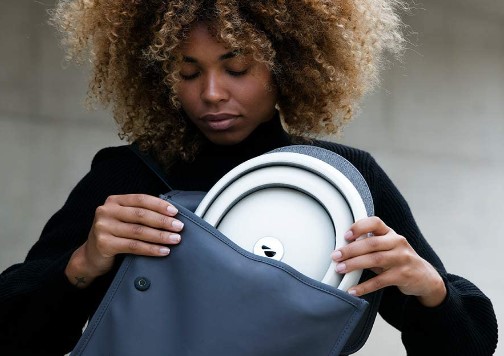
Frequently Asked Questions
1. Are Foldable Helmets Safe?
Yes. Before being approved for entry into the market, all helmets, including foldable ones, must be tested to ensure they can withstand shock and protect your head. They also have to be certified by the CPSC.
2. Are Some Helmets Safer Than Others?
Yes. All helmets provide basic protection during a crash, hence the testing and certification. However, some helmets use better quality materials than others, which may result in more safety.
Moreover, some helmets now come with Brain Protection System to protect your brain tissues from damage during a crash.
3. Are More Expensive Bike Helmets Safer?
No. Price does not determine how much protection you will get. Instead, what matters is that the helmet is certified, comfortable, perfect fit, and uses good quality material.
It is important to note that some helmets offer extra protection.
For example, a helmet with BPS in place, such as MIPS and Spherical Technology, protects better in case of impact. For such helmets, given the amount of research, time, and resources poured in during development and construction to make them safer, they could be more expensive than most.
4. Which Type of Bike Helmet Is Safest?
Primarily, a helmet’s purpose is to protect your head. Any standard helmet, so long as it has a CPSC sticker, is enough to offer basic protection.
Nevertheless, a helmet that uses MIPS technology is safer, as it protects your skull and brain.
5. What Helmet Is Safest for Kids?
Let’s go over the basics again. Even for young ones, the safest bike helmet is CPSC-certified, lightweight, and with adjustments to make it snugly fit.
A visor is an added advantage, especially if your kid is riding on trails or mountainous terrains, as it protects the face during impact.
MIPS technology is critical, as it will protect your child from any injury to the brain by allowing the helmet to rotate independently around the head.
In conclusion, are foldable bike helmets safer?
Certified collapsible bike helmets are safe. They all offer the same standard protection that other traditional helmets provide.
They are convenient for commuters, but other cyclists can also use them.
In this article, I have briefly discussed two of the best foldable bike helmets, Fend and Closca, and stated factors that make foldable bike helmets equally safe.
Relevant:
